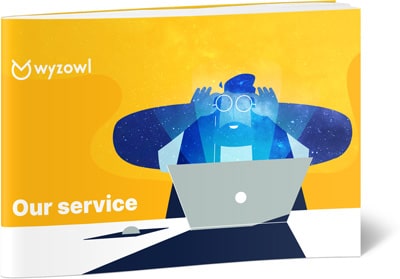Last updated on 25th October 2023
You’ve heard the hype – animated video is a powerful way to convey your message and make an impact on your audience.
But ‘animation’ – far from being one specific type of video – is a broad church. There are actually many different types of popular animation techniques available – from traditional flipbook animation to computer generated imagery and beyond.
Whether you want to create a classic cartoon, a motion graphic explainer video or an edgy animated GIF, there’s a type of animation for every brand out there – and the style you choose will say almost as much about your brand as the message of the video itself.
To illustrate this, and offer some inspiration, we’ve put together a list of the different types of animation out there – with examples, to show you how they can be used to bring your message alive. Let’s dive in!
11 Types of animation
2. Keyframe 2D
3. 3D
4. Stop motion
5. Animation mixed with live action
6. Motion graphics
7. Whiteboard
8. Typography
9. Claymation
10. Rotoscope
11. Mechanical
1. Frame-by-frame/traditional animation
This traditional animation technique – sometimes called flipbook animation or the stop-motion method – is like a flipbook come to life.
It’s an old-school style of animation, which involves drawing each frame individually with incremental changes in each image adding the sense of motion. It’s how early animated classics like Steamboat Willie (1928) were created.
While frame by frame gives animators full control over how their characters move and interact with their environment – the downside is that, obviously, it can be incredibly time consuming and labor intensive, which is why it tends to be less popular nowadays. After all, you’re drawing LITERALLY every frame, and most animated videos will run at a minimum of 12 frames per second (FPS).
However, when stop motion principles are combined with modern design software and talented artists, the results can be really impressive. The difference from other types of animation IS noticeable to the trained eye – it’s just a judgement call as to whether you feel that’s worth the considerable extra cost.
2. Keyframe 2D animation
Keyframe computer animation removes a lot of the time consuming work associated with stop motion. To put it in the most simple terms, keyframe animation lets you use computers to set the ‘key frames’ of an element or character’s movement – e.g. the beginning, the middle and the end of a movement – and a computer will then render the frames in between those points. This saves huge amounts of time and effort and makes animation a lot more accessible to a much wider range of brands.
It’s also incredibly flexible – once you’ve got your head around the technicalities, you can apply your own brand guidelines to create a diverse range of animated characters and animation styles that compliment and match your brand.
3. 3D animation
3D animation adds a third dimension – depth – to the animation equation, creating a highly dynamic animated environment that empowers marketers to craft realistic settings, characters, objects, textures, and lighting to vitalise their videos in new ways. Most of the modern animated movies you’re likely familiar with use this animation style; “Moana,” “Frozen,” and “Coco” are just three of thousands of 3D-animated movies created in the past several years. To see how brands are using this animation style as part of their video marketing strategy, check out the stunning examples below.
4. Stop motion animation
Stop motion is an animation technique through which physical objects are moved in small increments and individually photographed so that, when watched in rapid sequence, they create the feeling of movement. While this type of animation has been around since the late 1800s, it was made popular in the mid-1900s with some animated classics like “Rudolph the Red-Nosed Reindeer” and “Gumby.” Modern examples of stop motion include Wes Anderson’s latest film, “Isle of Dogs,” and the three dynamite examples we’ve included below.
(Watch this awesome behind-the-scenes video to see just how much work goes into creating a stop motion set!)
5. Animation mixed with live action
Why choose between animation and live-action video when you can have both? This powerful combo allows marketers to show real-life situations, and amplify them with animation layered on top of live-action footage. Check out how three major brands are using the benefits of both popular techniques to create unique styles and compelling stories.
6. Motion graphics
Motion graphics is a type of animated graphic design that usually features a lot of text and simple graphics. While traditional animated videos usually centre around characters and elaborate settings, motion graphics videos give life to stories that otherwise wouldn’t be visual, using shapes, graphics, and text to visually represent the story being told. As you watch these examples from three global brands, take a look at how even a simple approach to graphics amplifies the story being told verbally.
For more information and examples, check out our motion graphics company page.
7. Whiteboard animations
Whiteboard animation is a type of animation that features the illustrator physically drawing the artwork on a whiteboard or other surface using pens and markers. This animation style became popular shortly after the launch of YouTube in 2005. Even back then, brands were attracted to the way whiteboard animation let viewers see the story come to life before their eyes, and they’ve kept coming back to this timeless approach ever since. For three great examples, check out the videos we’ve included below that show the potential of whiteboard animation to wow an audience and tell a story at the same time.
8. Typography animation
Typography animation has become a popular way to bring life and energy to the screen. It basically refers to the animation of words and data, usually (though not always) in time with a voiceover. It tends to be fairly minimalist in style and can be used for anything from corporate presentations to music videos.
One of typography animation’s biggest strengths is its ability to quickly convey a message without the need for complex visuals. A simple text animation can be used to great effect, provided it is well-done – although, if done poorly, it can come across as cheesy or amateurish!
As always, trust Apple to do a great job…
On the other hand, typography animation also has its drawbacks. It’s usually limited to conveying only a single message and can be visually repetitive, making it difficult to use as a form of extended storytelling. Typography animation is better when it’s short and sweet. It also lacks the realistic visuals and intricate details that are possible with other forms of animation, and limits your ability to tell stories – after all, it’s impossible to create characters and take them on a journey.
In conclusion, typography animation offers a unique way to bring life and energy to your projects without the need for detailed visuals or extended storylines. While it may not be the best choice for all types of animation, it’s still a valuable tool and can be used to great effect in the right circumstances.
9. Clay animation (Claymation)
Clay animation is a type of stop motion animation that’s been around for many decades, but retains a timeless appeal.
It has a unique, distinct look that can’t be found with other forms of animated video.
Readers in the UK (and perhaps further afield) may be most familiar with beloved Aardman characters Wallace & Gromit as the most notable examples of clay animation.
On the plus side, clay animation is relatively simple to create – if you have the right skills in house! – and the stop-motion process can result in an enduringly beautiful end product. It has a wonderful, tactile quality to it.
On the downside, there’s no getting around it: clay animation is an incredibly time-consuming process and requires a lot of patience. It can be difficult to create smooth movements, which results in choppiness that detracts from the overall effect.
10. Rotoscope animation
Frame by rotoscope animation is like traditional animation on steroids! It requires a masterful use of technology – animators draw over film footage frame-by-frame, giving the animations a realistic look while still maintaining the qualities of hand-drawn animation. The process can be both time consuming and expensive, but the results can be spectacular. Frame by rotoscope animation can be used to great effect to create realistic and beautiful animated sequences.
The main strength of frame by rotoscope animation is that it combines the realism of film footage with the expressiveness of hand-drawn animation. The animations can also be incredibly detailed and precise, allowing animators to take advantage of minute changes in movements or expressions. The final product often looks incredibly natural, which can be great for creating truly realistic characters.
The main weakness of frame by rotoscope animation is the cost and time it takes to produce. Animators have to draw each individual frame, which can take a huge amount of time depending on the length and complexity of the scene. Additionally, due to the complexity of the process, mistakes can be hard to correct and adjustments may have to be made from scratch.
Despite its weaknesses, frame by rotoscope animation continues to be a technique beloved by animators for its realism and beauty. It is a great way to create animations that look realistic while still having the expressiveness of hand-drawn animation. In the end, it is a technique that definitely has its strengths and weaknesses, but can result in some truly stunning visuals.
11. Mechanical animation
Mechanical animation is a type of 3D animation. It involves creating realistic 3D renders of mechanical systems and their components, and it’s a great way, essentially, to show how things work. Particularly mechanical things – obviously!
For example, if you wanted to explain how a car engine worked…
The time involved in creating this kind of video tends to be front-loaded into creating the 3D model itself. Once the model’s done, it can be manipulated and moved to reinforce the points you’re making in your video.
The same principles can be applied to 3D product demo videos. You can create highly accurate 3D models of a physical product, then take your audience through its design, features and benefits in a highly dynamic way.
Wrapping up
The powers of these six types of animation are endless. From 30-second explainer videos to globally recognised feature films, animation has the power to tell stories of all shapes and sizes. As you set out to create an animated video, consider the following tips to determine the best type for your video.
1. Consider your brand: Each of these types of animation has a certain feel to it, and you should determine whether the animation style you choose accurately reflects your brand. For example, if you have a highly artistic brand, perhaps a stop motion or intricate 2D animation video is right for you. Meanwhile, a futuristic 3D style might make sense for a high-tech or scientific company.
2. Consider your competition: If you want to stand out from your competitors, take a look at what they’re doing and choose an animation approach that is different from (and better than) theirs. This differentiation will help you stand out amongst the competition and earn more attention and business from your customers.
3. Consider your budget: Each of these types of animation comes with a different price point. While visually stunning, stop motion animations often require a lot of resources; meanwhile, whiteboard videos can be a more economic approach. Be sure to have a handle on your budget before you select a style. For more information on how much explainer videos cost, check out our post on that topic.







